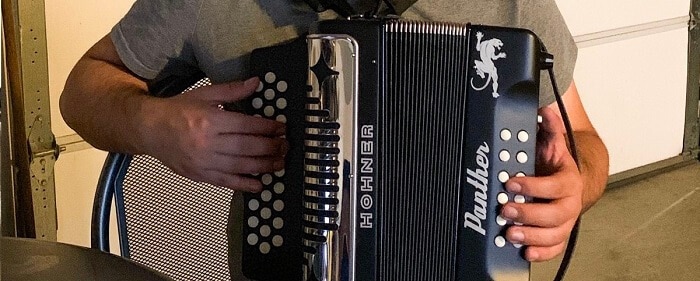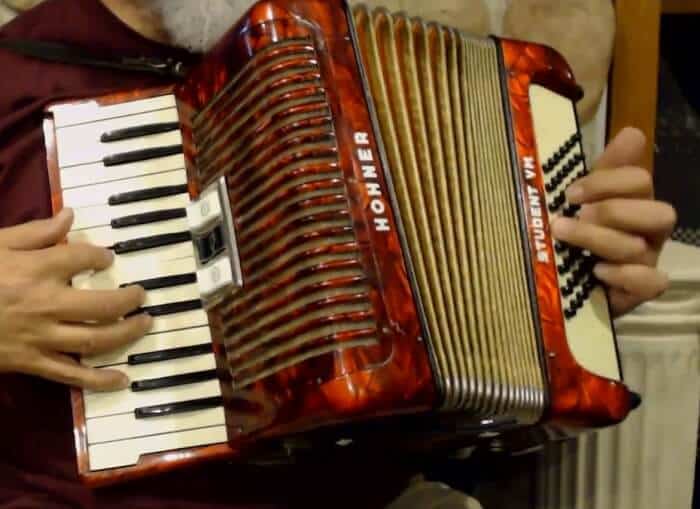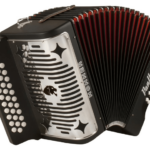When it comes to accordions, the two main types are the button accordion and piano accordion. There are pros and cons for each, but which is the best type for a beginner? What type of accordion is easier to play?
Once you have learned the buttons, the button accordion is easier to play than a piano accordion because the buttons are smaller and closer together than piano keys. This gives more fingering options and is easier to play multiple intervals and ranges quickly.
It can be harder to learn how to play a button accordion at first, as memorizing the buttons is generally harder than memorizing the piano keys on a piano accordion. This is especially true, of course, if you already know how to play the piano.
But the smaller buttons do come in handy and make it easier to play. Experienced button accordionists can cover around three octaves with a stretch of their hand. This would be impossible on a piano accordion.
Read on to learn more about what type of accordion is easier to play and why; as well as the differences between the button accordion and piano accordion.
Also, we hope you find the links here useful. If you purchase something through a link on this page, we may get a commission, so thank you!
And, take a look at one of the most popular button accordions, the Hohner Panther 3100GB button accordion. This is a super compact and lightweight diatonic accordion, weighing only 9 pounds.
Click here to see it on Amazon.
If you decide to go for a piano accordion, the Hohner BR48R-N 26-Key Piano Accordion is an excellent choice for beginners and seasoned accordionists alike.
Click here to see it on Amazon.
Piano vs Button Accordion
The two general types of accordions are the button accordion and the piano accordion. The button accordion is easier to play for beginners (once they learn the buttons) as they have fewer keys to press. Furthermore, the keys usually represent two notes. Also, some of the keys are for cosmetic purposes only.
On the button accordion, it’s also more convenient to play transitions from low notes to high notes because the buttons are closer and quicker to find. This decreases the risk of you playing the wrong note.
On the other hand, the piano accordion has buttons for almost every note so beginners may find this confusing. Just like a piano, you have to press various buttons to play.
To understand more about the differences between the button and piano accordion, here’s a comparison table you can refer to.
| Button Accordion: | Piano Accordion: | |
| Invented: | 1822 – Berlin, Germany | 1852 – Paris, France |
| Size and Weight: | Smaller and lighter | Larger and heavier |
| Keys: | Each button plays two notes | Each key plays one note |
| Difficulty in playing: | Easier to play once you learn the buttons Transposition is easier as there are duplicate rows More fingering options and faster fingering | Easier for professional piano players Transposition is difficult because of the range of keys Less fingering options |
| Buttons needed to sound a diatonic scale: | 4 buttons or 8 reeds | 8 keys or 16 reeds |
| Type of action: | Single action instrument (push-pull) | Double action instrument (press and draw) |
| Repertoire: | Narrower | Broader |
What is a Button Accordion?
The button accordion was the first type of accordion invented. It is mostly bisonoric (played with one or two keys) and has a variety of pitches based on the bellow action’s direction. But, there are exceptions, such as the garmon, which employs a double-action movement.
The side keyboard is commonly lined with one or more rows of buttons and is generally used for traditional folk music. There are paired buttons on the bass side of the keyboard. One button sounds of a set of three major or minor notes, while other buttons represent a harmonic set of pitches or a chord.
There are a few different types of button accordions, with the diatonic being the most popular. The diatonic scale typically features 7 notes, with each note representing two notes. This is why the button accordion is suitable for quick and lively folk dances or traditional music.
Pros
- More handy because of its lighter weight and smaller size
- Great for beginners as has fewer keys to play
- Suitable for traditional folk music
- Quick dances can be played as the notes are closer together
- Some find it simpler to play because it employs only one action, ‘push-pull’
Cons
- Can be difficult to memorize and learn the different buttons
As far as easy, entry-level accordions go, Hohner is the best brand. The Hohner Panther 3100GB button accordion is a super compact and lightweight diatonic accordion, weighing only 9 pounds.
Click here to see it on Amazon.
It has 31 treble keys, 2 sets of treble reeds, and 12 bass/chord keys. This accordion is one of the best value accordions out there for beginners.
What is a Piano Accordion?
The piano accordion is the most popular type of accordion, mostly due to the fact that many people are familiar with piano keys so find it easier to pick up and play.
It features the same keyboard as the piano. The keyboard is found on its right hand. However, this type of accordion is closer to an organ than a piano. The keys of the accordion are lighter to play, rounder, and smaller than the piano keys. The keys are in a vertical position towards the bellows. The keyboard is for the right hand to operate, while the left hand is left to operate the buttons of the instrument.
An accordion player can access the keyboard of this type using one hand. The problem lies in reaching keys that are far apart. Unless you have trained for this particular accordion or you’re a professional player, you may have difficulty stretching your fingers to reach different keys in a quick manner.
A pianist would find it easier to play the piano accordion naturally, as it would be smoother for them to adjust to the accordion’s keyboard. Those with other musical instrument backgrounds may also find it quicker to learn how to play the piano accordion.
Pros
- Wider-surface key area can make it easier to play, especially if have big fingers
- Each note has a specific key, so musicians won’t get confused
- Can be learned faster by those who already know how to play the piano
Cons
- Bulky to carry around because of its larger size
- Requires more finger movement to play
- Difficult to reach notes that are far apart
If you decide to go for a piano accordion, the Hohner BR48R-N 26-Key Piano Accordion is an excellent choice for beginners and seasoned accordionists alike.
Click here to see it on Amazon.
This accordion has a distinct sound with long-lasting quality and is at an affordable price point compared to other piano accordion brands. The weight of the Hohner BR48R-N is only about 15 pounds (6 kilos), so it also lighter than most other piano accordions.
What Type of Accordion is Easier to Play?
As mentioned earlier, if you’re a beginner, the button accordion should be your choice. However, if you’re a pianist or a pro in playing keys, you would find the piano accordion easier to play.
The button accordion is easier to play because the buttons are smaller and use fewer keys for notes, unlike the piano accordion that uses one key for each note. Hence, it’s larger in size and heavier than the button accordion. The numerous buttons for each note of the piano accordion can confuse beginners or non-professionals.
Although the button accordion is smaller, it can feature a maximum range of 64 playable notes. Not all button accordions provide this feature, however. The piano accordion usually has between 25 and 45 piano style treble keys on the right hand, and each key plays a specific note.
What Is the Easiest Type of Accordion for Beginners to Learn On?
First, you have to consider your level of knowledge about musical instruments. Are you familiar with any other musical instrument? If you know how to play the piano, then you can easily learn how to play the piano accordion. This is because both have similar keyboards. Also, if you know how to play the guitar or brass instruments, it can be easier to pick up and play the piano accordion.
You must know your purpose of wanting to learn how to play the accordion. What do you intend to play? Will you be transporting it often? If you intend to learn how to play modern jazz or more complex sounds, then you should learn on a piano accordion.
Nevertheless, if you’re a total novice, the button accordion is a better accordion for you because of the reasons mentioned above. Some people had experiences learning more easily with the piano accordion, but most beginners favored the button accordion as it’s lighter and easier to move around.
It’s also a matter of preference based on the importance you assign to the aesthetics or cost of each accordion.

What to Consider When Choosing Your Accordion
Below are some of the main factors to consider when choosing the best accordion for you:
Type of Accordion
There are various types of accordions to choose from. The two main categories are button and piano accordions.
The button and piano accordions are already discussed previously – each having its own pros and cons. You simply have to choose the one that is suitable for your goals.
Chromatic button accordions are generally unisonoric accordions. This means they produce only one pitch regardless of the bellow’s direction of action. All piano accordions are unisonoric and chromatic.
What You Will Use It For
What do you intend to play on your accordion? Do you plan to play a diverse melody or piano music? In case you want to do that, then the piano accordion is ideal, as you don’t need additional musical instruments to play complex notes.
With regards to the button accordion, it can play traditional music but you need additional musical instruments for keys that cannot be played by the accordion. When you don’t have intentions of going into the intricacies of music, then the button will do.
Convenience and Portability
In terms of convenience and portability, the button accordion wins because it’s smaller and lighter. However, there are now mini-piano accordions that are lighter and easier to carry and transport.
Mini-piano accordions are very affordable and are great for learning the basics before upgrading to a more advanced accordion. They are also tons of fun, though so small and lightweight – you can pick them up and play with ease.
The Wal Front 22-key, 8 Bass Piano Accordion is one such fun and easy-to-play beginner mini-accordion.
Click here to see it on Amazon.
This accordion has a well-built, durable, maple wood body, weighing only about 7.5 pounds. It is ergonomically designed for flexibility, and despite the affordable price, has a great sound.
Cost
Generally, accordions with more reeds are more expensive than those with fewer reeds. Button accordions generally cost less than piano accordions. Take note that not all expensive accordions are the best accordions, and not all cheap accordions are bad.
Weight and Size
Is the weight and size of the accordion proportional to your body built and size? Yes, you have to take into account if you’re able to carry the accordion and simultaneously play it as well.
There’s no point in buying the best accordion if you cannot hold it in your hands and play it. Is it portable enough? Would you be able to take it with you to your gigs? These are questions you have to ask yourself before selecting your accordion.
Compression and Reeds
Checking out the compression and reeds is crucial too. You can play the accordion by expanding or compressing the bellows. Are you able to expand and compress the bellows easily? How many reeds does your repertoire require?
Remember that the button accordion has fewer reeds (4) and is excellent for playing lively and traditional music. Conversely, the piano accordion has more reeds (16) and is ideal for modern jazz and similar sounds.
Conclusion – What Type of Accordion is Easier to Play?
If you have previous piano experience, a piano accordion will be easier to learn. A button accordion is typically easier to play once you have learned the buttons.
The button accordion has small buttons that are close together, so you will find it easier to play different intervals and ranges. You will also have more fingering options than a piano accordion.
On a piano accordion, the fingering is limited. You will have to jump around more to get close to similar ranges to the button accordion. A piano accordion also tends to be bigger and heavier unless you choose a mini-accordion.
When it comes down to it, you should get experience playing both types of accordions to know which is best for you. Just choose one and start playing so that you can start practicing and getting better each day.
Related reading:






![Accordion-like Instruments [Full List] accordion like instruments](https://musicalinstrumentpro.com/wp-content/uploads/2022/09/accordion-like-instruments-150x150.jpg)





